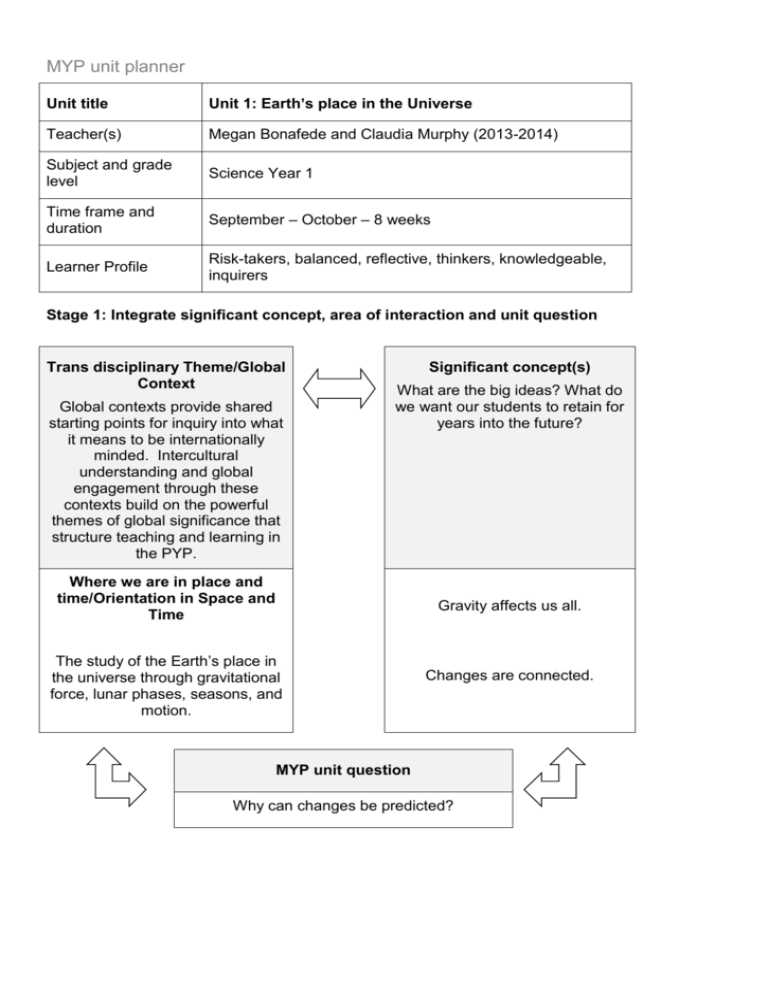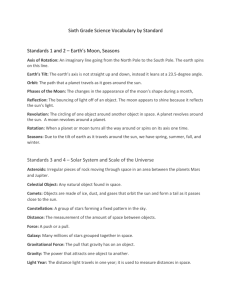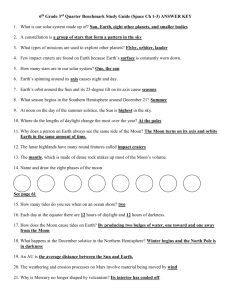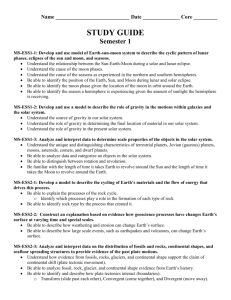MYP unit planner
advertisement

MYP unit planner Unit title Unit 1: Earth’s place in the Universe Teacher(s) Megan Bonafede and Claudia Murphy (2013-2014) Subject and grade level Science Year 1 Time frame and duration September – October – 8 weeks Learner Profile Risk-takers, balanced, reflective, thinkers, knowledgeable, inquirers Stage 1: Integrate significant concept, area of interaction and unit question Trans disciplinary Theme/Global Context Global contexts provide shared starting points for inquiry into what it means to be internationally minded. Intercultural understanding and global engagement through these contexts build on the powerful themes of global significance that structure teaching and learning in the PYP. Significant concept(s) What are the big ideas? What do we want our students to retain for years into the future? Where we are in place and time/Orientation in Space and Time Gravity affects us all. The study of the Earth’s place in the universe through gravitational force, lunar phases, seasons, and motion. Changes are connected. MYP unit question Why can changes be predicted? Assessment What task(s) will allow students the opportunity to respond to the unit question? What will constitute acceptable evidence of understanding? How will students show what they have understood? Summative Unit Assessment Which specific MYP objectives will be addressed during this unit? B Communication in Science -uses scientific language correctly, consistent with the level of complexity of the units of work covered C Knowledge and understanding of Science -with guidance, recall scientific knowledge and use scientific understanding to construct scientific explanations, consistent with the level of complexity of the units of work covered Which MYP assessment criteria will be used? Criterion B: Communication in Science Criterion C: Knowledge and understanding of Science Stage 2: Backward planning: from the assessment to the learning activities through inquiry Content What knowledge and/or skills (from the course overview) are going to be used to enable the student to respond to the unit question? What (if any) state, provincial, district, or local standards/skills are to be addressed? How can they be unpacked to develop the significant concept(s) for stage 1? Enduring Understanding What is the sun? • Know that the Sun is an averaged sized, yellow star. • Describe the properties of our Sun. • Compare and contrast the Sun to other bodies in our solar system. - million times more volume than the Earth - huge ball of gas and plasma How big is the Sun in terms of its volume/mass compared to: the Earth, the solar system, the galaxy? • Understand that stars look like tiny points of light because they are so far away. • Discuss distances in our solar system in terms of AU’s and explain we use this unit. • Understand the solar system is mostly empty space. How does distance from the Sun seem to affect the motion of the planet in its orbit? • Describe the general shape and direction of the orbits of the planets around the sun. Why don’t the planets crash into the Sun instead of orbiting around it? • Understand that every object in the universe exerts a gravitational force on every other object. • Explain that since the Sun is so large, and relatively close to the planets, that the gravitational force between them is strong enough to keep the planets in orbit. How are the motions of the Earth and other celestial objects used in determining our time scales? • Compare and contrast rotation vs. revolution. • Explain how the regular patterns of celestial bodies are used to explain and predict phenomena on Earth and elsewhere: - Movement of Sun, Moon, Stars, etc. through the sky - Tides - Comet appearance - Meteor showers - Eclipses (mention, more detail later) • Time is based on the movements of celestial bodies: - Year (Earth’s revolution: 365.25 days) - Day (Earth’s rotation: 24 hours) - Month (Moon’s revolution) What occurs during lunar and solar eclipses? • The mood is seen due to reflecting light from the Sun. • Explain the phases of the Moon based on both how it looks and why it occurs. • Describe the orientation of the Sun, Earth, and Moon during a lunar and solar eclipse. Where would you see Polaris from the following locations: North Pole, Rochester, Florida, Equator, Brazil, South Pole • Understand a globe is a circular model with a map of the Earth on it. • Compare and contrast latitude and longitude in terms of direction and how they are determined: - Latitude - N/S - Earth’s 15 degree per hour rotation - Longitude - E/W - Altitude of Polaris above horizon • Find and label locations on Earth’s surface by using latitude and longitude. • Recognize the Equator, Prime Meridian, and the North and South Hemispheres. How can it be winter in Rochester but summer in Sydney, Australia? • Explain why the number of hours of daylight changes throughout the year based on season and latitude. • Explain how the angle of the Sun’s rays change throughout the year and this is the main reason for the seasons. How do we know the earth is round? • Know that the Earth and most other celestial objects (stars, planets, and moons) are oblate spheroids. • Describe the shape of the Earth. New York State Standards 1.1a Earth’s Sun is an average-sized star. The Sun is more than a million times greater in volume than Earth. 1.1b Other stars are like the Sun but are so far away that they look like points of light. Distances between stars are vast compared to distances within our solar system. 1.1c The Sun and the planets that revolve around it are the major bodies in the solar system. Other members include comets, moons, and asteroids. Earth’s orbit is nearly circular. 1.1d Gravity is the force that keeps planets in orbit around the Sun and the Moon in orbit around the Earth. 1.1e Most objects in the solar system have a regular and predictable motion. These motions explain such phenomena as a day, a year, phases of the Moon, eclipses, tides, meteor showers, and comets. 1.1f The latitude/longitude coordinate system and our system of time are based on celestial observations. 1.1g Moons are seen by reflected light. Our Moon orbits Earth, while Earth orbits the Sun. The Moon’s phases as observed from Earth are the result of seeing different portions of the lighted area of the Moon’s surface. The phases repeat in a cyclic pattern in about one month. 1.1h The apparent motions of the Sun, Moon, planets, and stars across the sky can be explained by Earth’s rotation and revolution. Earth’s rotation causes the length of one day to be approximately 24 hours. This rotation also causes the Sun and Moon to appear to rise along the eastern horizon and to set along the western horizon. Earth’s revolution around the Sun defines the length of the year as 365 1/4 days. 1.1i The tilt of Earth’s axis of rotation and the revolution of Earth around the Sun cause seasons on Earth. The length of daylight varies depending on latitude and season. 1.1j The shape of Earth, the other planets, and stars is nearly spherical. Next Generation Science Standards (NGSS) MS-ESS1-1 Develop and use a model of the Earth-sun-moon system to describe the cyclic patterns of lunar phases, eclipses of the sun and moon, and seasons MS-ESS1-2 Develop and use a model to describe the role of gravity in the motions within galaxies and the solar system MS-ESS1-3 Analyze and interpret data to determine scale properties of objects in the solar system Next Generation Science Standards Core Ideas ESS1.A: The Universe and Its Stars Patterns of the apparent motion of the sun, the moon, and stars in the sky can be observed, described, predicted, and explained with models. (MS-ESS1-1) Earth and its solar system are part of the Milky Way galaxy, which is one of many galaxies in the universe. (MS-ESS1-2) ESS1.B: Earth and the Solar System The solar system consists of the sun and a collection of objects, including planets, their moons, and asteroids that are held in orbit around the sun by its gravitational pull on them. (MS-ESS1-2),(MS-ESS1-3) This model of the solar system can explain eclipses of the sun and the moon. Earth’s spin axis is fixed in direction over the short-term but tilted relative to its orbit around the sun. The seasons are a result of that tilt and are caused by the differential intensity of sunlight on different areas of Earth across the year. (MSESS1-1) The solar system appears to have formed from a disk of dust and gas, drawn together by gravity. (MS-ESS1-2) Vocabulary Sun Solar system Star Gravity Orbit Ellipse Gravitational attraction/force Universe Mass Property Cyclical Patterns Rotation Revolution Meteor showers Comets Moon Reflection Phases of the moon Solar eclipse Lunar eclipse Coordinate system Longitude Latitude Equator Hemisphere Axis Predictable Celestial observations Seasons Sun’s rays Axis Equinox (autumnal and vernal) Solstice (summer and winter) Oblate spheroid Approaches to learning How will this unit contribute to the overall development of subject-specific and general approaches to learning skills? Collaboration -collaborating in inquiry based groups Communication -Clear communication of information in their moon journals Thinking -Apply knowledge of concepts and drawing conclusions Organization -manage materials and resources Learning experiences Teaching strategies How will students know what is expected of them? Will they see examples, rubrics, templates? How will we use formative assessment to give students feedback during the unit? How will students acquire the knowledge and practise the skills required? How will they practise applying these? Do the students have enough prior knowledge? How will we know? General Skills: Students will follow safety procedures, use appropriate units for measured or calculated values, recognize and analyze patterns/trends, classify objects according to and established scheme, develop dichotomous key, sequence events, identify cause-and-effect relationships, and interpret results. What different teaching methodologies will we employ? How are we differentiating teaching and learning for all? How have we made provision for those learning in a language other than their mother tongue? How have we considered those with special educational needs? Formative Assessments -Quick writes -Moon Journal -Labs Teaching Methods -Use of graphic organizers -Short answer responses -Cornell Notes -Philosophical Chairs General Skills: Safely and accurately -Socratic Seminars use the following measuring tools: -WICOR Strategies metric ruler, balance, stopwatch, -Other AVID Science specific strategies graduated cylinder, thermometer, spring scale, and voltmeter. Differentiated Teaching -Pre-teaching vocabulary -Discuss what objects exist in our -Graphic organizers solar system: -Use of small group read alouds -Construct a model comparing the -Guided notes Sun to other bodies in our solar -Scaffolded questions system. -Discuss why the Earth stays in orbit. -Predict the amount of gravitational force acting on objects that have different masses and different distances from each other. -Moon phase tracking at home. Compare these drawings to charts on the internet: -Notice the same side of the moon is always facing us. -Use models and flashlight to demonstrate phases. -Construct a paper model of the Earth-Moon system. -Use magnetic compass to find cardinal directions -Draw and label a chart of the Sun and Earth positions, showing the equinoxes and solstices. -Use models to show the different in angles of the Sun’s rays for different seasons. -Measure the angular elevation of an object, using appropriate instruments Videos and CDs show the seasonal progression. Resources What resources are available to us? How will our classroom environment, local environment and/or the community be used to facilitate students’ experiences during the unit? -newspapers -maps -Encarta CD -AVID Write Path Science Guide -Prentice Hall Series On-going reflections and evaluation In keeping an on-going record, consider the following questions. There are further stimulus questions at the end of the “Planning for teaching and learning” section of MYP: From principles into practice. Students and teachers What did we find compelling? Were our disciplinary knowledge/skills challenged in any way? What inquiries arose during the learning? What, if any, extension activities arose? How did we reflect—both on the unit and on our own learning? Which attributes of the learner profile were encouraged through this unit? What opportunities were there for student-initiated action? Possible connections How successful was the collaboration with other teachers within my subject group and from other subject groups? What interdisciplinary understandings were or could be forged through collaboration with other subjects? Assessment Were students able to demonstrate their learning? How did the assessment tasks allow students to demonstrate the learning objectives identified for this unit? How did I make sure students were invited to achieve at all levels of the criteria descriptors? Are we prepared for the next stage? Data collection How did we decide on the data to collect? Was it useful? Figure 12 MYP unit planner








